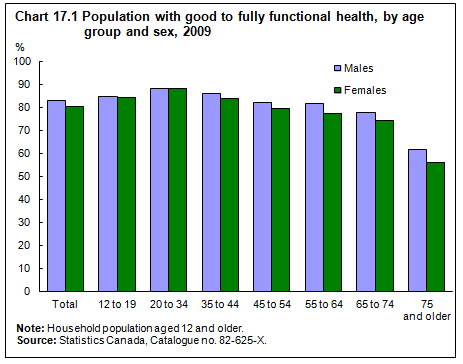Health
Archived Content
Information identified as archived is provided for reference, research or recordkeeping purposes. It is not subject to the Government of Canada Web Standards and has not been altered or updated since it was archived. Please "contact us" to request a format other than those available.
Related information
Canadians are generally healthy and the health status of the population remained stable from 2003 to 2009. Of Canadians aged 12 and older, 82% were in good to fully functional health in 2008, according to an index that measures a person's functional health using eight attributes: vision, hearing, speech, mobility, dexterity, feelings, cognition and pain.
Having a regular doctor is associated with early screening and treatment of medical conditions. In 2009, 85% of Canadians aged 12 and older reported having a regular medical doctor, down from 86% in 2003. That means 4.3 million people did not have a regular doctor in 2009. Men in all age groups except those aged 12 to 19 were significantly more likely than women to not have a regular doctor.
In 2009, 82% of Canadians who did not have a regular medical doctor reported having a place that they usually went when ill or in need of health advice. Of those, 61% reported using a walk-in clinic when they needed medical care, 13% visited a hospital emergency room and 9% used a community health centre.
Health differences between men and women
An enduring difference between the sexes when it comes to health is that men are generally more likely than women to be overweight or obese and to develop diabetes. In 2009, 18% of Canadians aged 18 and older—roughly 4.4 million adults—reported height and weight that classified them as obese. From 2003 to 2009, obesity among women rose from 15% to 17%, but among men it increased from 16% to 19%.
Among obese or overweight women, 2 out of 5 had increased health risks because of their excess weight in 2009, whereas 3 out of 5 obese or overweight men did. Besides type 2 diabetes, some chronic diseases linked with obesity are hypertension, cardiovascular disease, osteoarthritis and certain types of cancer.
From 2001 to 2009, men were more likely than women to report having diabetes. In 2009, 5.3% of females aged 12 and older reported diabetes, versus 6.6% of males.
From 2003 to 2009, a higher percentage of men than women were exposed to second-hand smoke at home. In 2009, men aged 20 to 34 and aged 65 and older were significantly more likely than women in those age groups to be exposed to second-hand smoke at home.
Hypertension and cholesterol
In 2009, 17% of Canadians aged 12 and older reported having high blood pressure. This was not a significant change from 2008, though it was an increase from 16% in 2007. In 2009, females (17%) were more likely than males (16%) to report that they had been diagnosed with hypertension. From ages 12 to 54, men had significantly higher hypertension rates. From ages 55 to 64, rates were similar for men and women, and from age 65 and older, women had the higher rates.
Generally, higher hypertension is associated with unhealthy levels of total cholesterol, triglycerides and 'bad' (LDL) cholesterol. More than 2 in 5 Canadians aged 20 to 79 had an unhealthy level of total cholesterol in the March 2007 to February 2009 period, and about 1 in 4 had an unhealthy level of triglycerides.
Though men tend to rate their health more positively than women do, they are more likely than women to die at earlier ages. In 2007, life expectancy at birth was 83.0 years for females and 78.3 years for males—a difference of 4.7 years. However, this gap narrowed from 5.8 years in 1997.
Activity levels
From 2007 to 2009, just over half (53%) of adults accumulated at least 30 minutes of moderate-to-vigorous physical activity one or more days a week, but this means that almost as many (47%) did so less than one day a week.
About 5% of adults accumulated 150 minutes of moderate-to-vigorous physical activity on a regular basis, that is, 30 minutes a day at least five days a week.
As the proportion of seniors in the population increases, so too does the prevalence of many chronic conditions. In 2006, cancer, heart disease and stroke—the three leading causes of death—were responsible for 58% of all deaths. All three are more prevalent in an aging population. Chronic conditions place a burden on individuals, families and the health care system, but they are often a consequence of longevity, which in itself is a positive indicator of the Canadian population's health status.
- Date modified:

